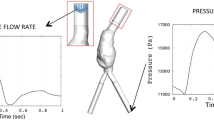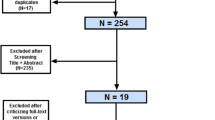Abstract
Objectives
To evaluate imaging changes occurring in a rat model of elastase-induced abdominal aortic aneurysm (AAA), with emphasis on the intraluminal thrombus (ILT) occurrence.
Methods
The post-induction growth of the AAA diameter was characterized using ultrasound in 22 rats. ILT was reported on 13 rats that underwent 14 magnetic resonance imaging (MRI) 2-18 days post-surgery, and on 10 rats that underwent 18 fluoro-deoxyglucose (FDG) positron emission tomography (PET)/microcomputed tomography examinations 2-27 days post-surgery. Logistic regressions were used to establish the evolution with time of AAA length, diameter, ILT thickness, volume, stratification, MRI and FDG PET signalling properties, and histological assessment of inflammatory infiltrates.
Results
All of the following significantly increased with time post-induction (p < 0.001): AAA length, AAA diameter, ILT maximal thickness, ILT volume, ILT iron content and related MRI signalling changes, quantitative uptake on FDG PET, and the magnitude of inflammatory infiltrates on histology. However, the aneurysm growth peak followed occurrence of ILT approximately 6 days after elastase infusion.
Conclusion
Our model emphasizes that occurrence of ILT precedes AAA peak growth. Aneurysm growth is associated with increasing levels of iron, signalling properties changes in both MRI and FDG PET, relating to its biological activities.
Key Points
• ILT occurrence in AAA is associated with increasing FDG uptake and growth.
• MRI signalling changes in ILT reflect activities such as haemorrhage and RBC trapping.
• Monitoring ILT activities using MRI may require no exogenous contrast agent.





Similar content being viewed by others
References
Dobrin PB (1989) Pathophysiology and pathogenesis of aortic aneurysms. Current concepts. Surg Clin N Am 69:687–703
Michel JB, Martin-Ventura JL, Egido J et al (2011) Novel aspects of the pathogenesis of aneurysms of the abdominal aorta in humans. Cardiovasc Res 90:18–27
Sakalihasan N, Limet R, Defawe OD (2005) Abdominal aortic aneurysm. Lancet 365:1577–1589
Touat Z, Lepage L, Ollivier V et al (2008) Dilation-dependent activation of platelets and prothrombin in human thoracic ascending aortic aneurysm. Arterioscler Thromb Vasc Biol 28:940–946
Sarda-Mantel L, Coutard M, Rouzet F et al (2006) 99mTc-annexin-V functional imaging of luminal thrombus activity in abdominal aortic aneurysms. Arterioscler Thromb Vasc Biol 26:2153–2159
Fontaine V, Touat Z, el Mtairag M et al (2004) Role of leukocyte elastase in preventing cellular re-colonization of the mural thrombus. Am J Pathol 164:2077–2087
Houard X, Rouzet F, Touat Z et al (2007) Topology of the fibrinolytic system within the mural thrombus of human abdominal aortic aneurysms. J Pathol 212:20–28
Martinez-Pinna R, Madrigal-Matute J, Tarin C et al (2013) Proteomic analysis of intraluminal thrombus highlights complement activation in human abdominal aortic aneurysms. Arterioscler Thromb Vasc Biol 33:2013–2020
Martinez-Pinna R, Lindholt JS, Madrigal-Matute J et al (2014) From tissue iron retention to low systemic haemoglobin levels, new pathophysiological biomarkers of human abdominal aortic aneurysm. Thromb Haemost 112:87–95
Defawe OD, Colige A, Lambert CA et al (2003) TIMP-2 and PAI-1 mRNA levels are lower in aneurysmal as compared to athero-occlusive abdominal aortas. Cardiovasc Res 60:205–213
Fontaine V, Jacob MP, Houard X et al (2002) Involvement of the mural thrombus as a site of protease release and activation in human aortic aneurysms. Am J Pathol 161:1701–1710
Folkesson M, Kazi M, Zhu C et al (2007) Presence of NGAL/MMP-9 complexes in human abdominal aortic aneurysms. Thromb Haemost 98:427–433
Marbacher S, Marjamaa J, Bradacova K et al (2014) Loss of mural cells leads to wall degeneration, aneurysm growth, and eventual rupture in a rat aneurysm model. Stroke 45:248–254
Mitchell DG, Burk DL Jr, Vinitski S, Rifkin MD (1987) The biophysical basis of tissue contrast in extracranial MR imaging. AJR Am J Roentgenol 149:831–837
Winner MW 3rd, Sharkey-Toppen T, Zhang X et al (2014) Iron and noncontrast magnetic resonance T2* as a marker of intraplaque iron in human atherosclerosis. J Vasc Surg. doi:10.1016/j.jvs.2014.02.006
Lindholt JS, Bjorck M, Michel JB (2013) Anti-platelet treatment of middle-sized abdominal aortic aneurysms. Curr Vasc Pharmacol 11:305–313
Touat Z, Ollivier V, Dai J et al (2006) Renewal of mural thrombus releases plasma markers and is involved in aortic abdominal aneurysm evolution. Am J Pathol 168:1022–1030
Anidjar S, Salzmann JL, Gentric D, Lagneau P, Camilleri JP, Michel JB (1990) Elastase-induced experimental aneurysms in rats. Circulation 82:973–981
Feldkamp LDL, Kress J (1984) Practical cone-beam algorithm. JOSA A 1:612–619
Bahri MA, Plenevaux A, Warnock G, Luxen A, Seret A (2009) NEMA NU4-2008 image quality performance report for the microPET focus 120 and for various transmission and reconstruction methods. J Nucl Med 50:1730–1738
Defrise M, Kinahan PE, Townsend DW, Michel C, Sibomana M, Newport DF (1997) Exact and approximate rebinning algorithms for 3-D PET data. IEEE Trans Med Imaging 16:145–158
Nguyen-Legros J, Bizot J, Bolesse M, Pulicani JP (1980) "Diaminobenzidine black" as a new histochemical demonstration of exogenous iron (author's transl). Histochemistry 66:239–244
Coutard M, Touat Z, Houard X, Leclercq A, Michel JB (2010) Thrombus versus wall biological activities in experimental aortic aneurysms. J Vasc Res 47:355–366
Defawe OD, Hustinx R, Defraigne JO, Limet R, Sakalihasan N (2005) Distribution of F-18 fluorodeoxyglucose (F-18 FDG) in abdominal aortic aneurysm: high accumulation in macrophages seen on PET imaging and immunohistology. Clin Nucl Med 30:340–341
Reeps C, Bundschuh RA, Pellisek J et al (2013) Quantitative assessment of glucose metabolism in the vessel wall of abdominal aortic aneurysms: correlation with histology and role of partial volume correction. Int J Cardiovasc Imaging 29:505–512
Nchimi A, Cheramy-Bien JP, Gasser TC et al (2014) Multifactorial relationship between 18F-fluoro-deoxy-glucose positron emission tomography signaling and biomechanical properties in unruptured aortic aneurysms. Circ Cardiovasc Imaging 7:82–91
English SJ, Piert MR, Diaz JA et al (2015) Increased 18F-FDG uptake is predictive of rupture in a novel rat abdominal aortic aneurysm rupture model. Ann Surg 261:395–404
Michineau S, Dai J, Gervais M et al (2010) Aortic length changes during abdominal aortic aneurysm formation, expansion and stabilisation in a rat model. Eur J Vasc Endovasc Surg 40:468–474
Rai D, Wisniowski B, Bradshaw B et al (2014) Abdominal aortic aneurysm calcification and thrombus volume are not associated with outcome following endovascular abdominal aortic aneurysm repair. Eur Radiol 24:1768–1776
Nchimi A, Defawe O, Brisbois D et al (2010) MR Imaging of Iron Phagocytosis in Intraluminal Thrombi of Abdominal Aortic Aneurysms in Humans. Radiology 254:973–981
Richards JM, Semple SI, MacGillivray TJ et al (2011) Abdominal aortic aneurysm growth predicted by uptake of ultrasmall superparamagnetic particles of iron oxide: a pilot study. Circ Cardiovasc Imaging 4:274–281
Klink A, Heynens J, Herranz B et al (2011) In vivo characterization of a new abdominal aortic aneurysm mouse model with conventional and molecular magnetic resonance imaging. J Am Coll Cardiol 58:2522–2530
Rouzet F, Bachelet-Violette L, Alsac JM et al (2011) Radiolabeled fucoidan as a p-selectin targeting agent for in vivo imaging of platelet-rich thrombus and endothelial activation. J Nucl Med 52:1433–1440
Nahrendorf M, Keliher E, Marinelli B et al (2011) Detection of macrophages in aortic aneurysms by nanoparticle positron emission tomography-computed tomography. Arterioscler Thromb Vasc Biol 31:750–757
de Valk B, Marx JJ (1999) Iron, atherosclerosis, and ischemic heart disease. Arch Intern Med 159:1542–1548
Nguyen VL, Leiner T, Hellenthal FA et al (2014) Abdominal Aortic Aneurysms with High Thrombus Signal Intensity on Magnetic Resonance Imaging are Associated with High Growth Rate. Eur J Vasc Endovasc Surg. doi:10.1016/j.ejvs.2014.04.025
Morin-Roy F, Kauffmann C, Tang A et al (2014) Impact of contrast injection and stent-graft implantation on reproducibility of volume measurements in semiautomated segmentation of abdominal aortic aneurysm on computed tomography. Eur Radiol 24:1594–1601
Acknowledgments
The authors thank Mrs. Cécile Wegria and Carmela La Mantia for manuscript handling, editing and management; Jacques Trentesaux, Jean-Marc Léonard, and Jean-François Monville, M.D. for their kind assistance and advice in MRI. The scientific guarantor of this publication is Natzi Sakalihasan MD, PhD. The authors of this manuscript declare no relationships with any companies, whose products or services may be related to the subject matter of the article. This study has received funding by the 7th European Framework Program collaborative project: Fighting Aneurysmal Disease (FAD). Adelin Albert, PhD and Laurence Seidel PhD kindly provided statistical advice for this manuscript. Institutional Review Board approval was obtained. Approval from the institutional animal care committee was obtained. Methodology: prospective, experimental, performed at one institution.
Author information
Authors and Affiliations
Corresponding author
Electronic supplementary material
Below is the link to the electronic supplementary material.
Rights and permissions
About this article
Cite this article
Nchimi, A., Courtois, A., El Hachemi, M. et al. Multimodality imaging assessment of the deleterious role of the intraluminal thrombus on the growth of abdominal aortic aneurysm in a rat model. Eur Radiol 26, 2378–2386 (2016). https://doi.org/10.1007/s00330-015-4010-y
Received:
Revised:
Accepted:
Published:
Issue Date:
DOI: https://doi.org/10.1007/s00330-015-4010-y




